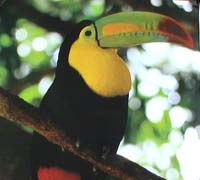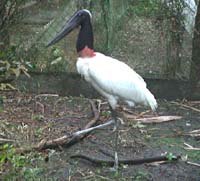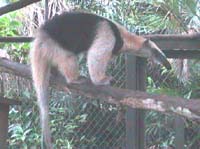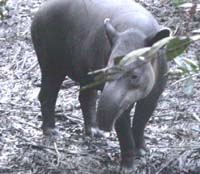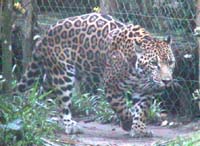 |
|||||||||||||||||||
After breakfast at our rainforest basecamp at Ian Anderson's Jungle Lodge we got in our 4-wheel drive and drove back toward Belize City. On our way we stopped at the Belize Zoo to see some of the animals that live in the rainforest, but we didn't see during our hikes through the rainforest. Like a coral reef a rainforest is home for many different kinds of animals. In a rainforest it is harder to see the animals that live there compared to a coral reef. The Belize Zoo is part of the natural environment that has been fenced off as a home for over 125 animals. All the animals at the zoo are found in Belize. The zoo keeps animals which were either orphaned, born at the zoo, rehabilitated animals, or sent to the Belize Zoo as gifts from other zoos. At the zoo we are the only visitors, so we have the zoo and the animals to ourselves. The first animal we see high in a tree above us is the Belize national bird. It is the keel-billed toucan (TOO-can). We see the toucan's huge bill. It is yellow, orange, red, green and black. As we watch the toucan snips a fruit off the tree. Then it flips its head back and gulps down the fruit. The toucan eats mainly fruit, but also insects, small reptiles, and other birds' eggs. There are about 543 different kinds of birds in of Belize, but only a few are here at the zoo. We see another bird in a huge nest at the top of a tree. The bird stands, spreads its huge wings and flies to the ground. This is one of the largest birds in Central America. It is the giant Jabiru stork. It is about 5 feet tall and has a wingspan of 8 feet across! The Jabiru stork is a very rare and endangered bird. Only about 24 Jabirus have been seen in Belize. With their long bills Jabiru storks catch and eat fish and frogs, lizards, snakes and small mammals. About 145 different kinds of mammals live in Belize. Rainforest mammals are usually scared of people and often feed at night. This makes them very difficult to see. Fortunately the zoo has some rainforest mammals that we can see. The first mammal we see is the giant anteater. The giant anteater is the largest anteater. Including the tail it can grow over 6 feet long! We are surprised to see the anteater up and walking around because anteaters sleep up to 15 hours a day! Anteaters eat ants and termites. An anteater has no teeth, but its tongue is about two feet long! The anteater sticks its long tongue into an anthole to lick up ants. An anteater can live to be about 26 years old. As we walk along a raised walkway we see a large animal moving between the trees. It is the largest land mammal that lives in the rainforest, the tapir (TAPE-ear). This is Belize's national animal. People in Belize call it the "mountain cow". Tapirs can grow over 6 feet long and weigh up to 500 pounds! The tapir is related to the horse and the rhino. We think the tapir looks like Shrek with a long nose. Tapirs eat only plants like grasses, water plants, leaves, buds, and fruits of small shrubs. Tapirs can live to be up to 22 years old. Finally we see the animal we wanted to see the most, a jaguar! The Mayans believed the jaguar was the god of the dead. (Remember the Mayan pot we found with a jaguar head painted on it in the Cave of the Dead?) Jaguars used to live from Arizona to Argentina. Now jaguars are gone from many areas. Belize has one of the healthiest populations in Central America, because the jaguar is protected from being hunted. In the zoo enclosure we see two jaguars, one is orange with spots, the other is all black. The black jaguar is the most rare jaguar and the one the Mayans thought was the most sacred. These jaguars are about 5 feet long. They can grow to over 6 feet long and live to be about 22 years old. Jaguars eat mammals, birds, fish, frogs, and turtles. The zoo is closing so it is time for us to leave and continue our drive to Belize City and get on our ship, Nantucket Clipper. Join us for the next part of our expedition to explore more of the rainforests of Belize, Guatemala, and Honduras. Best fishes, |
TODAY'S DATA The Belize Zoo, Belize The keel-billed toucan is the Belize national bird. This toucan can grow up to 20 inches long.
This Jabiru stork is about 5 feet tall.
This giant anteater is about 5 feet long.
This tapir is about 5 feet long. We think this tapir looks like Shrek with a long nose.
The jaguar is about 5 feet long. |
||||||||||||||||||
home | basecamp | archives | library other expeditions | kids' page | contact us © 2001, The Ocean Adventure All rights reserved. |
